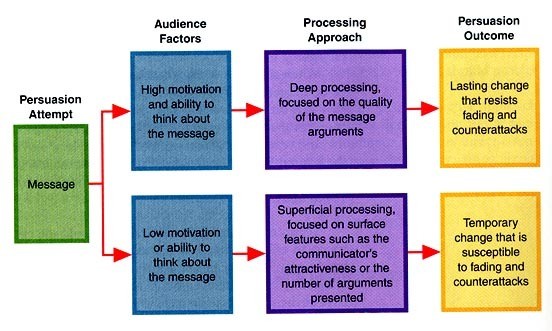The Secret Sauce of Persuasion: ELM's Recipe for Influential Appeals
In the realm of communication and persuasion, the art of swaying others to your viewpoint holds immense power and complexity. Allow me to introduce the Elaboration Likelihood Model (ELM), a persuasion theory formulated by Petty and Cacioppo. This model sheds light on how individuals process persuasive messages and provides valuable guidance on the art of crafting well-developed appeals to the psyche. It's time to learn the recipe for how ELM theory can shape the way you construct persuasive appeals.
Understanding the Two Pathways
ELM suggests that people engage in two distinct modes of processing persuasive messages: the central route and the peripheral route. The choice between these routes hinges on the audience's motivation and their ability to process information.
When your audience is highly motivated and possesses the capacity to delve into complex information, directing your efforts toward the central route is paramount. Even LinkedIn mentions this in their Business Coaching articles! Here's how to tailor persuasive appeals for this route:
Compelling Arguments: Develop compelling arguments that resonate with your audience's values and interests. Your message should be logically structured and meticulously reasoned.
Credibility Matters: Furnish credible sources and evidence to underpin your assertions. The presence of trustworthy information amplifies the persuasive impact of your message.
Emphasize Benefits: Highlight the advantages and merits of adopting your viewpoint. Show how it aligns with the audience's objectives and aspirations.
Essentially, these tenets are nigh-identical toward the tenets of public speech and academic debate -- make good arguments, cite your sources & leverage credibility over quantity, and discuss the positive impacts of the view.
When your audience lacks the motivation or the cognitive resources for deep engagement with your message, focusing on the peripheral route becomes imperative. Shape your persuasive appeals according to these principles:
Endorsements of Trustworthiness: Harness endorsements from reputable figures or organizations to cultivate credibility.
Harnessing Emotional Appeal: Elicit emotions through storytelling or compelling narratives that strike a chord with your audience's sentiments.
Visual Allure: Create eye-catching visuals, encompassing images and videos, to arrest attention. Just like I am required to do in the blog post, you should strive to grasp the attention of the reader by leveraging multimedia where possible! Cue the required graphic!
The Elaboration Likelihood Model:
You can visualize just how the top section (the central route) and the bottom section (the peripheral route) will function here!
Repetition can be a persuasive tactic in both routes:
Central Route: Reiterating key points and arguments can reinforce your message.
Peripheral Route: Repeated exposure to your message, even without deep cognitive processing, can augment persuasion through familiarity and positive associations with the content of the message!
One-size-fits-all approaches seldom yield success in persuasion, or many other aspects of life. Customize your message to resonate with your audience and you'll be able to persuade like a pro!
If you intend to persuade via the central route:
- Make sure to engage in critical contemplation of the issue. Present counterarguments and address objections to demonstrate your consideration of alternative viewpoints.
In fact, a fusion of central and peripheral elements may yield optimal results. If you find yourself having trouble, try to begin with a well-thought-out central argument and complement it with peripheral messagesto engage a broader spectrum of audience members. This is a core strategy to ensure the most people are affected by the message in question.
Take a look at the below video by Michael Britt to see a comprehensive breakdown of the model in visual form, and when you come back, leave a comment and let me know how you think the model can be applied in everyday life!
